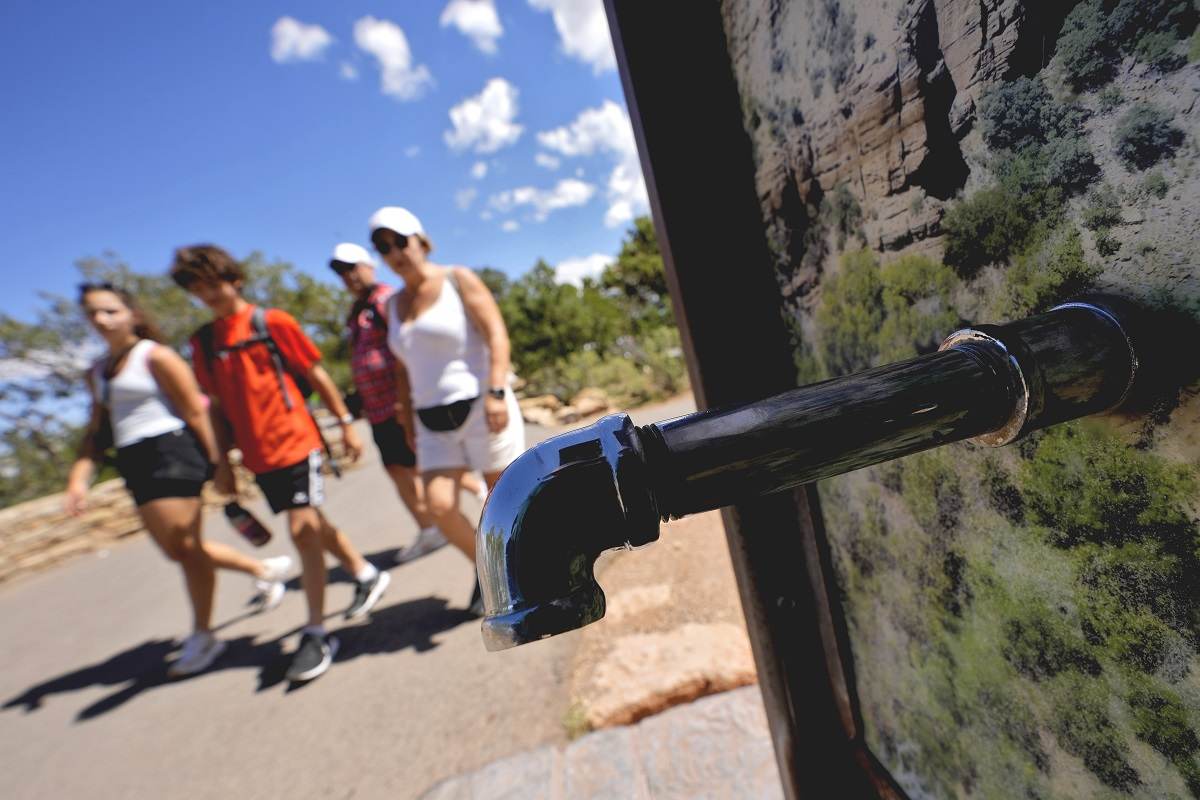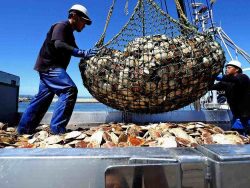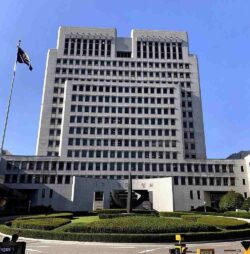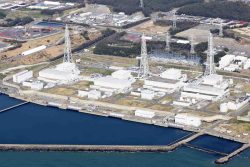Grand Canyon’s Main Water Line Has Broken Dozens of Times. Why Is It Getting a Major Fix Only Now?

A group of day visitors walk past a closed water bottle tap along the Rim Trail, as visitors won’t be able to stay overnight in hotels or refill water bottles at Grand Canyon National Park after a series of breaks in the only pipeline that serves the popular tourist destination, Thursday, Aug. 29, 2024, in Grand Canyon, Ariz
13:52 JST, September 9, 2024
On a scorching day in June 2013, the Grand Canyon discouraged hikers from making a long trek to the bottom because there would be no potable water. A set of historic cabins and bunks also would be closed overnight because of a water pipeline break.
The incident was one of more than 85 breaks that the 12.5-mile (20-kilometer) long Transcanyon Waterline, which supplies potable water to the Grand Canyon’s South Rim and inner canyon, has experienced since 2010. Finished in 1970, the pipeline has long exceeded its 30-year design life, disrupting operations at one of the most popular U.S. national parks.
The pipeline has remained a leaky, flimsy albeit vital piece of infrastructure for millions of visitors. This year, after multiple breaks, officials imposed water restrictions and canceled overnight stays at busy hotels, upending some summer vacations over Labor Day weekend.
A long-term fix is expected by roughly 2027, but it’s taken decades to get to that point. The lengthy timeline is due to a complex design process and the challenge of funding expensive projects at the National Park Service, which struggles under mountains of overdue maintenance, according to experts who know its history.
“It just takes awhile for something this big,” said Robert Parrish, chief of planning, environment and projects at Grand Canyon National Park, adding that it’s not just the park service — utilities can take 10 to 15 years to start building big projects.
Recent stays at El Tovar Hotel, Bright Angel Lodge and other hotels on the canyon’s South Rim were halted for roughly a week as officials rushed to patch up four breaks in the water line.
The Transcanyon pipeline twists and turns over the canyon’s rugged terrain. For years, the park service repaired pipeline failures from rock falls, freezes, flash floods and other causes on an ad hoc basis, Parrish said. One 2015 estimate said over roughly the previous three decades, the pipeline suffered five to 30 breaks per year. Those cost on average about $25,000 each.
It isn’t like fixing most pipelines, according to Dan Cockrum, chief of maintenance and engineering at the park for nearly a decade until 1993.
Helicopters had to shuttle workers to the leak. They would measure the damaged pipe’s thickness and bend, return to the rim and craft a replacement piece, then head back down to install the new section, he recalled.
Leaks happened a few times a year. Around when Cockrum left that job, engineers studied replacing the entire thing or its most vulnerable portions, because it was suffering stress fractures and corrosion and was near the end of its useful life. But the plan for a major fix wasn’t adopted.
“When you have inadequate resources it comes down to sort of a triage approach,” said Ernie Atencio, Southwest regional director with the National Parks Conservation Association and a former Grand Canyon ranger. “You do the best you can for as long as you can. And sometimes things will blow up on you.”
In the short term, a piecemeal approach may have made economic sense. A few repairs a year were significantly cheaper than the tens of millions of dollars for a replacement project, according to Greg MacGregor, chief of the project management team at the park from 2006 to 2017.
That thinking shifted toward a permanent solution in the early 2010s, Parrish said.
“Instead of looking at a large number of small repair projects, the teams really transitioned to ‘how do we look at making an overall replacement of the entire system?'” he said.
MacGregor remembers a huge brainstorm process to figure out the best option and years of analyzing how to solve the complex problem of moving scarce water up to the South Rim.
The park service has hurried to fix breaks, some bigger than others, and slowly save for a major overhaul, Parrish said, “There was too much to tackle at once.”
In 2018, the National Park Service released an environmental assessment, asked for public input, then the next year officials signed off on a more comprehensive fix. The Transcanyon Waterline project will involve replacing about 3 miles (5 kilometers) of pipe inside the canyon, upgrading 3 miles (5 kilometers) of electrical supply line inside the canyon, building a water intake at a new location and updating water treatment and electrical systems.
Officials say the project will ensure the park will be able to meet its water supply needs for the next 50 years or more.
Funding was one of the biggest hurdles. The park’s maintenance backlog kept growing during MacGregor’s time, and he remembers Congress was reluctant to write a big check. The park would end up contributing from visitor fees. In 2018, fees went up in part to help pay for the pipeline.
U.S. national parks fund costly maintenance work mainly through Congress but also from donations, philanthropy and park entrance fees. Large parks like the Grand Canyon, with nearly 5 million visitors in 2023, don’t keep everything they receive from entrance fees; larger parks distribute a portion of fees to smaller parks, many of which don’t charge visitors. Grand Canyon keeps 80% of its visitor fees, Parrish said.
A $208 million construction contract was awarded in 2023. Congress provided more than $70 million for the project but the bulk will come from park fees, Parrish said.
“The sheer magnitude of the scope of this project is maybe the answer to why it took so long to decide, plan and execute,” he said.
Over the years, breaks have taken a toll.
Wendy Haluda is a former baker at El Tovar Hotel where diners this spring could order a filet mignon with a demi glace for $54. After a pipeline break in 2016, water restrictions forced the restaurant to reduce dishwashing and use paper plates and plastic utensils. And Haluda recalled staff worrying about where they would go if conditions worsened to where they couldn’t stay overnight at their park housing.
“It was scary,” she recalled.
Badly needed repairs, maintenance and infrastructure replacement like the Grand Canyon’s pipeline are a nationwide problem. The park service has a nearly $23 billion maintenance backlog for aging infrastructure.
More than half that is for road work and maintaining buildings at national parks. The remainder is for water systems, trails, campground and infrastructure such as wastewater treatment.
The Grand Canyon has a backlog of $823 million for maintenance and repairs, mostly maintaining buildings and trails.
The Great American Outdoors Act of 2020 provided billions in additional funding, although it will expire soon if Congress doesn’t renew it.
A lot of park infrastructure dates 70 years or more and upkeep has been neglected, according to Tate Watkins, a researcher at the think tank Property and Environment Research Center.
“People like cutting ribbons on new national parks,” he said. “But it’s a lot less sexy to talk about fixing sewer lines or, you know, rebuilding a water line for the Grand Canyon.”
"News Services" POPULAR ARTICLE
-

American Playwright Jeremy O. Harris Arrested in Japan on Alleged Drug Smuggling
-

Taiwan President Shows Support for Japan in China Dispute with Sushi Lunch
-

Japan’s Nikkei Stock Average as JGB Yields, Yen Rise on Rate-Hike Bets
-

Japan’s Nikkei Stock Average Licks Wounds after Selloff Sparked by BOJ Hike Bets (UPDATE 1)
-

Japanese Bond Yields Zoom, Stocks Slide as Rate Hike Looms
JN ACCESS RANKING
-

Japan’s Hopes for Seafood Exports Shot Down in China Spat
-

Keidanren Chairman Yoshinobu Tsutsui Visits Kashiwazaki-Kariwa Nuclear Power Plant; Inspects New Emergency Safety System
-

Japan to Charge Foreigners More for Residence Permits, Looking to Align with Western Countries
-

Imports of Rare Earths from China Facing Delays, May Be Caused by Deterioration of Japan-China Relations
-

Japan Exports Rise in October as Slump in U.S. Sales Eases

























